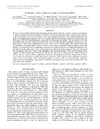Identificador persistente para citar o vincular este elemento:
https://accedacris.ulpgc.es/jspui/handle/10553/73941
| Campo DC | Valor | idioma |
|---|---|---|
| dc.contributor.author | Filho, M. E. | en_US |
| dc.contributor.author | Sánchez Almeida, J. | en_US |
| dc.contributor.author | Muñoz-Tuñón, C. | en_US |
| dc.contributor.author | Nuza, S. E. | en_US |
| dc.contributor.author | Kitaura, F. | en_US |
| dc.contributor.author | Heß, S. | en_US |
| dc.date.accessioned | 2020-08-04T08:26:11Z | - |
| dc.date.available | 2020-08-04T08:26:11Z | - |
| dc.date.issued | 2015 | en_US |
| dc.identifier.issn | 0004-637X | en_US |
| dc.identifier.other | Scopus | - |
| dc.identifier.other | WoS | - |
| dc.identifier.uri | https://accedacris.ulpgc.es/handle/10553/73941 | - |
| dc.description.abstract | We have analyzed bibliographical observational data and theoretical predictions, in order to probe the environment in which extremely metal-poor dwarf galaxies (XMPs) reside. We have assessed the H I component and its relation to the optical galaxy, the cosmic web type (voids, sheets, filaments and knots), the overdensity parameter and analyzed the nearest galaxy neighbors. The aim is to understand the role of interactions and cosmological accretion flows in the XMP observational properties, particularly the triggering and feeding of the star formation. We find that XMPs behave similarly to Blue Compact Dwarfs; they preferably populate low-density environments in the local universe: similar to 60% occupy underdense regions, and similar to 75% reside in voids and sheets. This is more extreme than the distribution of irregular galaxies, and in contrast to those regions preferred by elliptical galaxies (knots and filaments). We further find results consistent with previous observations; while the environment does determine the fraction of a certain galaxy type, it does not determine the overall observational properties. With the exception of five documented cases (four sources with companions and one recent merger), XMPs do not generally show signatures of major mergers and interactions; we find only one XMP with a companion galaxy within a distance of 100 kpc, and the H I gas in XMPs is typically well-behaved, demonstrating asymmetries mostly in the outskirts. We conclude that metal-poor accretion flows may be driving the XMP evolution. Such cosmological accretion could explain all the major XMP observational properties: isolation, lack of interaction/merger signatures, asymmetric optical morphology, large amounts of unsettled, metal-poor H I gas, metallicity inhomogeneities, and large specific star formation. | en_US |
| dc.language | eng | en_US |
| dc.relation.ispartof | The Astrophysical journal | en_US |
| dc.source | The Astrophysical journal [ISSN 0004-637X], v. 802 (2), (Abril 2015) | en_US |
| dc.subject | 21 Astronomía Astrofísica | en_US |
| dc.subject.other | Galaxies: Dwarf | en_US |
| dc.subject.other | Galaxies: Evolution | en_US |
| dc.subject.other | Galaxies: Formation | en_US |
| dc.subject.other | Galaxies: Interactions | en_US |
| dc.subject.other | Galaxies: Starburst | en_US |
| dc.title | Extremely metal-poor galaxies: The environment | en_US |
| dc.type | info:eu-repo/semantics/Article | en_US |
| dc.type | Article | en_US |
| dc.identifier.doi | 10.1088/0004-637X/802/2/82 | en_US |
| dc.identifier.scopus | 84926655547 | - |
| dc.identifier.isi | 000353014500010 | - |
| dc.contributor.authorscopusid | 7005151816 | - |
| dc.contributor.authorscopusid | 6603818270 | - |
| dc.contributor.authorscopusid | 35575927400 | - |
| dc.contributor.authorscopusid | 15846299500 | - |
| dc.contributor.authorscopusid | 12808521500 | - |
| dc.contributor.authorscopusid | 36241533800 | - |
| dc.identifier.eissn | 1538-4357 | - |
| dc.identifier.issue | 2 | - |
| dc.relation.volume | 802 | en_US |
| dc.investigacion | Ingeniería y Arquitectura | en_US |
| dc.type2 | Artículo | en_US |
| dc.contributor.daisngid | 1278182 | - |
| dc.contributor.daisngid | 241308 | - |
| dc.contributor.daisngid | 1621454 | - |
| dc.contributor.daisngid | 1263124 | - |
| dc.contributor.daisngid | 479170 | - |
| dc.contributor.daisngid | 30645241 | - |
| dc.description.numberofpages | 16 | en_US |
| dc.utils.revision | Sí | en_US |
| dc.contributor.wosstandard | WOS:Filho, ME | - |
| dc.contributor.wosstandard | WOS:Almeida, JS | - |
| dc.contributor.wosstandard | WOS:Munoz-Tunon, C | - |
| dc.contributor.wosstandard | WOS:Nuza, SE | - |
| dc.contributor.wosstandard | WOS:Kitaura, F | - |
| dc.contributor.wosstandard | WOS:Hess, S | - |
| dc.date.coverdate | Abril 2015 | en_US |
| dc.identifier.ulpgc | Sí | es |
| dc.description.sjr | 3,282 | |
| dc.description.jcr | 5,909 | |
| dc.description.sjrq | Q1 | |
| dc.description.jcrq | Q1 | |
| dc.description.scie | SCIE | |
| item.fulltext | Con texto completo | - |
| item.grantfulltext | open | - |
| Colección: | Artículos | |
Citas SCOPUSTM
35
actualizado el 08-jun-2025
Citas de WEB OF SCIENCETM
Citations
36
actualizado el 08-jun-2025
Visitas
130
actualizado el 01-feb-2025
Descargas
191
actualizado el 01-feb-2025
Google ScholarTM
Verifica
Altmetric
Comparte
Exporta metadatos
Los elementos en ULPGC accedaCRIS están protegidos por derechos de autor con todos los derechos reservados, a menos que se indique lo contrario.
